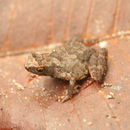en
names in breadcrumbs


Dendrophryniscus minutus és una espècie d'amfibi que viu al Brasil, Bolívia, Colòmbia, Equador, Guaiana Francesa, Guaiana, Perú, Surinam i, possiblement també, a Veneçuela.
Es troba amenaçada d'extinció per la pèrdua del seu hàbitat natural.
Dendrophryniscus minutus és una espècie d'amfibi que viu al Brasil, Bolívia, Colòmbia, Equador, Guaiana Francesa, Guaiana, Perú, Surinam i, possiblement també, a Veneçuela.
Es troba amenaçada d'extinció per la pèrdua del seu hàbitat natural.
Amazophrynella minuta is a species of toad in the family Bufonidae. It is found in Bolivia, Brazil, Colombia, Ecuador, French Guiana, Guyana, Peru, Suriname, and Venezuela. However, because of the poor description of new Amazophrynella species, it is not clear which old records refer to this species and which records refer to the new species.[2]
Amazophrynella minuta is a forest floor species found in old and second-growth tropical moist forest and premontane humid forest. Breeding takes place in semi-permanent and temporary waterbodies. It is threatened by habitat loss.[1] These are small toads with a maximum snout–vent length of about 24 mm (0.94 in).[3]
Amazophrynella minuta is a species of toad in the family Bufonidae. It is found in Bolivia, Brazil, Colombia, Ecuador, French Guiana, Guyana, Peru, Suriname, and Venezuela. However, because of the poor description of new Amazophrynella species, it is not clear which old records refer to this species and which records refer to the new species.
Amazophrynella minuta is a forest floor species found in old and second-growth tropical moist forest and premontane humid forest. Breeding takes place in semi-permanent and temporary waterbodies. It is threatened by habitat loss. These are small toads with a maximum snout–vent length of about 24 mm (0.94 in).
El sapo diminuto de hojarasca (Amazophrynella minuta)[1] es una especie de anfibio de la familia Bufonidae.[2]
Se encuentra en Bolivia, Brasil, Colombia, Ecuador, Guyana Francesa, Guyana, Perú, Surinam y Venezuela.[3]
Su hábitat natural incluye bosques secos tropicales o subtropicales, ríos intermitentes y marismas de agua dulce.
El sapo diminuto de hojarasca (Amazophrynella minuta) es una especie de anfibio de la familia Bufonidae.
Se encuentra en Bolivia, Brasil, Colombia, Ecuador, Guyana Francesa, Guyana, Perú, Surinam y Venezuela.
Su hábitat natural incluye bosques secos tropicales o subtropicales, ríos intermitentes y marismas de agua dulce.
Dendrophryniscus minutus Dendrophryniscus generoko animalia da. Anfibioen barruko Bufonidae familian sailkatuta dago, Anura ordenan.
Amazophrynella minuta est une espèce d'amphibiens de la famille des Bufonidae[1].
Cette espèce se rencontre en Amérique du Sud jusqu'à 1 000 m d'altitude[2] :
Sa présence au Venezuela n'a été confirmé qu'en 2013[3].
Amazophrynella minuta est une espèce d'amphibiens de la famille des Bufonidae.
Amazophrynella minuta – gatunek płaza bezogonowego z rodziny ropuchowatych (Bufonidae).
Płaz ten zalicza się do rodziny ropuchowatych[6]. Czasami umieszczany w rodzaju Dendrophryniscus.
Rozważa się możliwość, że chodzi tutaj o kilka gatunków[6].
Aktywność tego zwierzęcia przypada na dzień[6].
Płaz rozmnaża się w zbiornikach wodnych powstających naturalnie. Mogą one istnieć tylko tymczasowo. Samica składa jaja, umieszczając je na korzeniach roślin, znajdujących się nad zbiornikiem wodnym, w którym przebiega później rozwój kijanek[6].
W przeciwieństwie do wielu swych krewnych, endemitów Brazylii[7][8][9][10][11], płaz ten obejmuje swym zasięgiem występowania liczne kraje. Prócz Brazylii spotyka się go w Boliwii, Kolumbii, Ekwadorze, Gujanie Francuskiej, Gujanie, Surinamie i Peru. Na zachodzie sięga podnóża Andów, występuje zarówno w zlewisku Amazonki, jak i Orinoko[6].
Gatunek zazwyczaj żyje na wysokościach nie przekraczających 300 m nad poziomem morza, jednakże w okolicy Puyo na terenie Ekwadoru spotyka się go na wysokości 1000 m nad poziomem morza. Bytuje na dnie lasu[6].
Płaz występuje obficie (wyjątek stanowi tutaj Boliwia, na terenie której zwierzę stanowi rzadkość). Jego całkowita liczebność utrzymuje się na stałym poziomie. International Union for Conservation of Nature w 2004 przyznała mu status gatunku najmniejszej troski (LC – least Concern)[6].
Wśród zagrożeń dla gatunku IUCN wymienia czynniki zagrażające lasom, w których żyje: pozyskiwanie drewna, zmiany zachodzące w lesie i trawiące go pożary[6].
Z uwagi na szeroki zasięg występowania gatunek żyje na licznych terenach chronionych[6].
Amazophrynella minuta – gatunek płaza bezogonowego z rodziny ropuchowatych (Bufonidae).
Amazophrynella minuta é uma espécie de anfíbio da família Bufonidae. Pode ser encontrada na Bolívia, Brasil, Colômbia, Equador, Guiana Francesa, Guiana, Peru, Suriname e Venezuela.[2][3]
Os seus habitats naturais são: florestas subtropicais ou tropicais húmidas de baixa altitude, rios intermitentes e marismas intermitentes de água doce. Está ameaçada por perda de habitat.
Amazophrynella minuta é uma espécie de anfíbio da família Bufonidae. Pode ser encontrada na Bolívia, Brasil, Colômbia, Equador, Guiana Francesa, Guiana, Peru, Suriname e Venezuela.
Os seus habitats naturais são: florestas subtropicais ou tropicais húmidas de baixa altitude, rios intermitentes e marismas intermitentes de água doce. Está ameaçada por perda de habitat.
Dendrophryniscus minutus là một loài cóc thuộc họ Bufonidae. Loài này có ở Bolivia, Brasil, Colombia, Ecuador, Guyane thuộc Pháp, Guyana, Peru, Suriname, và có thể cả Venezuela. Môi trường sống tự nhiên của chúng là rừng ẩm vùng đất thấp nhiệt đới hoặc cận nhiệt đới, sông có nước theo mùa, và đầm nước ngọt có nước theo mùa. Chúng hiện đang bị đe dọa vì mất nơi sống.
Phương tiện liên quan tới Dendrophryniscus minutus tại Wikimedia Commons
Dendrophryniscus minutus là một loài cóc thuộc họ Bufonidae. Loài này có ở Bolivia, Brasil, Colombia, Ecuador, Guyane thuộc Pháp, Guyana, Peru, Suriname, và có thể cả Venezuela. Môi trường sống tự nhiên của chúng là rừng ẩm vùng đất thấp nhiệt đới hoặc cận nhiệt đới, sông có nước theo mùa, và đầm nước ngọt có nước theo mùa. Chúng hiện đang bị đe dọa vì mất nơi sống.